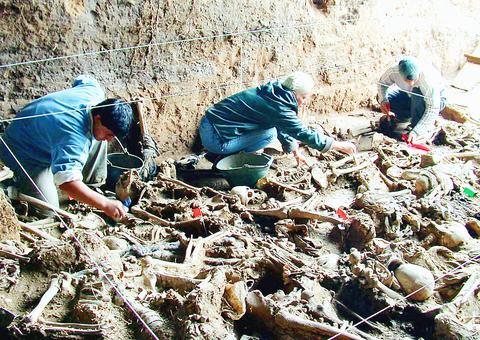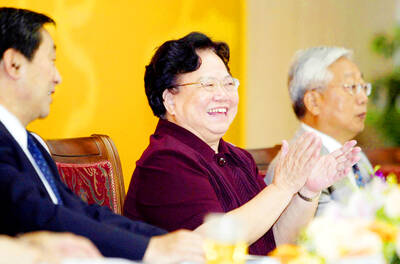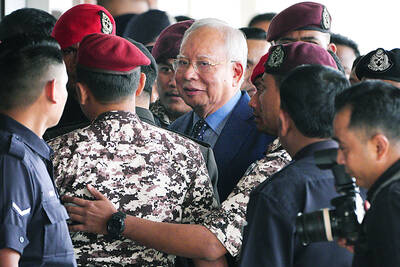In a dank mortuary, forensic anthropologist Dario Olmo pores over a carefully laid-out skeleton, piecing together the horrors of Argentina's recent past bone by bone.
Beside ribs stained brown with mud and age sits a tangle of stocking and nylon cord -- the sinister key to the man's fate at the hands of the brutal 1976-83 military dictatorship.
"This man had something around his neck that strangled him. The savagery is inexplicable," said Olmo, striving to identify dozens of the junta's victims recovered from a secret mass grave in Cordoba, 800km northwest of Buenos Aires -- the biggest found to date.

PHOTO: REUTERS
As the Argentine Forensic Anthropologists Team unearths the truth two decades after military rule collapsed, those responsible for the cruelty may now finally face justice.
Long shielded by Argentine amnesty laws, hundreds of ageing former military officers could lose their immunity and face possible extradition to stand trial abroad for the kidnapping, torture and murder of 10,000 to 30,000 people -- mostly suspected leftists -- who "disappeared" under the junta.
New left-leaning President Nestor Kirchner, himself persecuted as a student, wants to see those who he says "decimated" his generation held accountable.
"Reconciliation cannot arise from silence or complicity," he warned military top brass this month. "We must separate the wheat from the chaff, each taking responsibility for his actions."
A top Foreign Ministry source said Kirchner is seeking to annul a decree that bans extradition of ex-military accused of rights abuses -- and so pave the way for them to be tried abroad.
The initiative follows Mexico's recent extradition of former Argentine navy officer Ricardo Cavallo to Spain to face genocide and terrorism charges in what was hailed as a watershed for human rights.
Crusading Spanish judge Baltasar Garzon, who has sought the extradition of dozens of former Argentine officials, is now trying to freeze the assets of 96 ex-soldiers and police officers he accuses of dictatorship-era crimes.
Former Chilean dictator Augusto Pinochet's escape from extradition for rights crimes stemming from his own iron-fisted 1973-90 rule has not deterred relatives of Argentina's disappeared in their campaign to bring the guilty to justice.
"Kirchner's initiative is very welcome; it is a breath of fresh air," said Aida Sarti of the Mothers of the Plaza de Mayo, which groups parents whose children disappeared. "But we want the amnesty laws annulled too so the [accused] can be put on trial here."
In recent months courts have declared the so-called 1987 Full Stop and Due Obedience laws unconstitutional, and the Supreme Court is expected to take up the issue.
Judges convicted a number of high-ranking military officials after the dictatorship fell.
Coup leader Jorge Videla lives under house arrest, while ex-navy head Emilio Eduardo Massera, who ran an infamous torture center, is ailing and bedridden. Former General Leopoldo Galtieri, who led Argentina into the disastrous Falklands War, died this year.
But many officers were later pardoned, and the frustration of families who want to know what really happened is palpable. They still hold out hope of recovering a body to mourn.
Protesters this month waved banners reading "Justice and punishment for the genocidal" at a soccer match to celebrate the 25th anniversary of Argentina's 1978 World Cup win.
Back at the mortuary, the forensic anthropologists are resorting to similar tests to identify the dead, gluing together skulls shattered by bullets and studying dental records for clues.
Standing beside the gaping mass grave in a cemetery on the outskirts of this provincial capital, where around 40 suspected disappeared were tossed along with hospital waste and rubbish, Olmo is fighting against the odds.
His team, which helped find the remains of Marxist revolutionary Che Guevara in Bolivia, has recovered the remains of hundreds of Argentine disappeared over the years and has identified around 100.
"There are plenty of remains that will never be recovered," he said. "Thousands."

The death of a former head of China’s one-child policy has been met not by tributes, but by castigation of the abandoned policy on social media this week. State media praised Peng Peiyun (彭珮雲), former head of China’s National Family Planning Commission from 1988 to 1998, as “an outstanding leader” in her work related to women and children. The reaction on Chinese social media to Peng’s death in Beijing on Sunday, just shy of her 96th birthday, was less positive. “Those children who were lost, naked, are waiting for you over there” in the afterlife, one person posted on China’s Sina Weibo platform. China’s

‘NO COUNTRY BUMPKIN’: The judge rejected arguments that former prime minister Najib Razak was an unwitting victim, saying Najib took steps to protect his position Imprisoned former Malaysian prime minister Najib Razak was yesterday convicted, following a corruption trial tied to multibillion-dollar looting of the 1Malaysia Development Berhad (1MDB) state investment fund. The nation’s high court found Najib, 72, guilty on four counts of abuse of power and 21 charges of money laundering related to more than US$700 million channeled into his personal bank accounts from the 1MDB fund. Najib denied any wrongdoing, and maintained the funds were a political donation from Saudi Arabia and that he had been misled by rogue financiers led by businessman Low Taek Jho. Low, thought to be the scandal’s mastermind, remains

‘POLITICAL LOYALTY’: The move breaks with decades of precedent among US administrations, which have tended to leave career ambassadors in their posts US President Donald Trump’s administration has ordered dozens of US ambassadors to step down, people familiar with the matter said, a precedent-breaking recall that would leave embassies abroad without US Senate-confirmed leadership. The envoys, career diplomats who were almost all named to their jobs under former US president Joe Biden, were told over the phone in the past few days they needed to depart in the next few weeks, the people said. They would not be fired, but finding new roles would be a challenge given that many are far along in their careers and opportunities for senior diplomats can

Australian Prime Minister Anthony Albanese yesterday announced plans for a national bravery award to recognize civilians and first responders who confronted “the worst of evil” during an anti-Semitic terror attack that left 15 dead and has cast a heavy shadow over the nation’s holiday season. Albanese said he plans to establish a special honors system for those who placed themselves in harm’s way to help during the attack on a beachside Hanukkah celebration, like Ahmed al-Ahmed, a Syrian-Australian Muslim who disarmed one of the assailants before being wounded himself. Sajid Akram, who was killed by police during the Dec. 14 attack, and